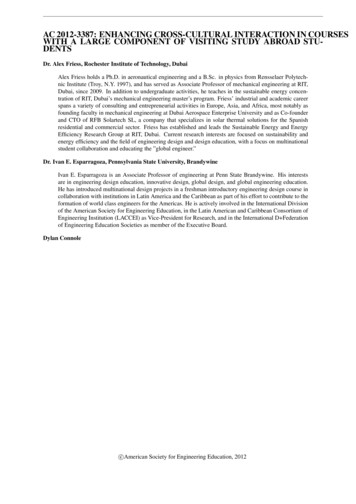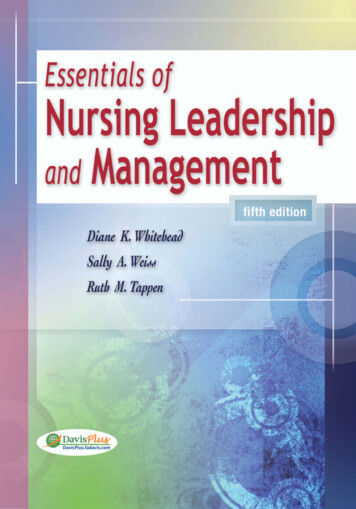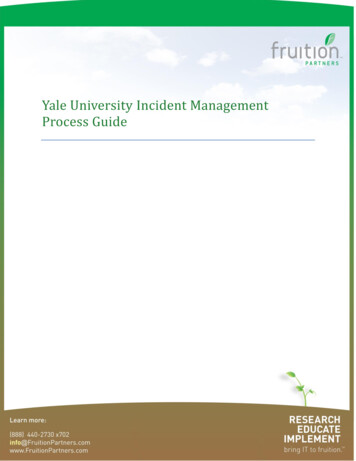
Transcription
AC 2012-3387: ENHANCING CROSS-CULTURAL INTERACTION IN COURSESWITH A LARGE COMPONENT OF VISITING STUDY ABROAD STUDENTSDr. Alex Friess, Rochester Institute of Technology, DubaiAlex Friess holds a Ph.D. in aeronautical engineering and a B.Sc. in physics from Rensselaer Polytechnic Institute (Troy, N.Y. 1997), and has served as Associate Professor of mechanical engineering at RIT,Dubai, since 2009. In addition to undergraduate activities, he teaches in the sustainable energy concentration of RIT, Dubai’s mechanical engineering master’s program. Friess’ industrial and academic careerspans a variety of consulting and entrepreneurial activities in Europe, Asia, and Africa, most notably asfounding faculty in mechanical engineering at Dubai Aerospace Enterprise University and as Co-founderand CTO of RFB Solartech SL, a company that specializes in solar thermal solutions for the Spanishresidential and commercial sector. Friess has established and leads the Sustainable Energy and EnergyEfficiency Research Group at RIT, Dubai. Current research interests are focused on sustainability andenergy efficiency and the field of engineering design and design education, with a focus on multinationalstudent collaboration and educating the ”global engineer.”Dr. Ivan E. Esparragoza, Pennsylvania State University, BrandywineIvan E. Esparragoza is an Associate Professor of engineering at Penn State Brandywine. His interestsare in engineering design education, innovative design, global design, and global engineering education.He has introduced multinational design projects in a freshman introductory engineering design course incollaboration with institutions in Latin America and the Caribbean as part of his effort to contribute to theformation of world class engineers for the Americas. He is actively involved in the International Divisionof the American Society for Engineering Education, in the Latin American and Caribbean Consortium ofEngineering Institution (LACCEI) as Vice-President for Research, and in the International D Federationof Engineering Education Societies as member of the Executive Board.Dylan Connolec American Society for Engineering Education, 2012
Enhancing cross-cultural interaction in courses with alarge component of visiting study-abroad studentsAbstractInternational student mobility programs enhance the global exposure of students, andrepresent a vital and increasing component in the offering of many universities worldwide.These programs often involve the travel of a group of students to an overseas location, wherethey, in addition to a variety of cultural activities, also register for a series of courses towardstheir degree completion. These courses are taken jointly with their local peers. Whilecollaborative exchange programs among different universities often target individual studentmobility, and the travelling student (or small group of students) generally represents aminority in the overseas class, in the case of branch campuses, and due to the seamlessintegration of the academic coursework and perhaps more systematic organization of thestudy abroad experience, an increasingly homogeneous and larger travelling student groupcan result, which may in turn imply that the visiting students can represent a large fraction ofa class. This more even distribution between study abroad and local students can generateclassroom dynamics that effectively split the class into two groups, and thus are notsupportive of the cross-cultural interaction dimension of the international experience.This work discusses the observed barriers to cross-cultural collaboration in the classroom atthe Dubai campus of Rochester Institute of Technology (RTI), where this effect has beennoted in a senior/graduate level course in renewable energy systems that was composed byover 50% of study-abroad students from the main campus. Class dynamics of preferablyworking with peers from the same background developed, in part due to an easier out-of-classaccess to these peers, and in part due to a higher comfort level in the peer interaction. Whilethe academic learning outcomes were met by both groups, this experience has shown that inorder to increase cross-cultural interaction in the classroom, specific learning criteria andoutcomes that stress global competencies need to be introduced. This paper presents thelessons learned in the process (including out of classroom factors that affect in classroomcollaboration), and presents a work in progress of designing appropriate learning objectives,activities and assessment tools to foster development of global competencies in classes with alarge and homogeneous component of study abroad students.IntroductionOver the past two decades, and in light of the growing globalization of industry and business,global competencies have evolved into an important component in university level education.In particular engineering, with its traditionally lesser focus on process skills, has increasedawareness of the importance of these skills in a global and international environment.Through the introduction of the 2000 ABET criteria, this need has been further recognized,and integrated as one of the basic outcomes of any engineering program1. In 2004 theNational Academies published The Engineer of 20202, followed in 2005 by Educating theEngineer of 20203. Later, the National Academies was asked by representatives of the U.S.Senate and House of Representatives to formulate strategies that policymakers could proposeso the U.S. can successfully compete, prosper, and secure the global community of the 21stcentury. The resulting report, Rising above the Gathering Storm4 was published in 2006. Thatyear, Continental Corporation5 funded the first scientific global engineering study conductedby eight prestigious universities around the world5. The study resulted in fourrecommendations: (1) A key qualification of engineering graduates must be global
competence; (2) transnational mobility for engineering students, researchers, andprofessionals needs to become a priority; (3) global engineering excellence critically dependson a partnerships, especially those that link engineering education to professional practice;and (4) research is urgently needed on engineering in a global context.The challenges of educating world class engineers with global competencies have generatedchanges in the paradigm of engineering education that explore great variety ofteaching/learning approaches with the aim of forming the future engineers with a set ofprofessional skills to be productive and competitive in the global economy. Those approachesinvolve different initiatives including online collaboration, multinational projects, andsemester or yearlong study abroad experiences among the most common ones6,7.As a result of the need of forming engineers with global competencies, RIT has been veryactive in creating international opportunities for their students. In order to facilitate thisinternational experience, RIT, and through its global campuses initiative, has established aseries of global branch campuses and programs in Kosovo, Croatia, the Dominican Republic,and finally Dubai. The United Arab Emirates (UAE) campus is the largest one, and the onlyone that offers undergraduate engineering programs. While still ramping up its operation,RIT Dubai has already been very successful in attracting study abroad students from the maincampus. This paper discusses the observed barriers to cross-cultural collaboration in theclassroom at the Dubai campus of RTI, where this effect has been noted in a senior/graduatelevel course composed by over 50% of study-abroad students from the main US campus.Faculty and students observations about the class interaction are presented and somerecommendations are formulated to enhance the cross cultural experience with the aim tofacilitate the development of global competencies in engineering students.RationaleThe need of educating engineers not only with solid technical knowledge but also with a setof professional skills including global competencies has been understood by the academia.What might be still a topic of discussion is the definition of global competencies. From theengineering perspective, it can be argued that global competencies are a set of knowledge andskills that allow people to work effectively with others that think and act differently due tocultural differences. Other definitions include a shift in perception from an ethno-centricstandpoint, where the own culture and environment assumes a central role, to an ethnorelative standpoint, where the own position is seen as a simple constituent of a globalenvironment8. Warnick9 compiled information and suggested the set of global competenciesnecessaries for engineers to succeed in a global environment and those attributes aresummarized in Table 1:Table 1: Common Global Competencies1Exhibit global mindset2Appreciate and understand different cultures3Demonstrate world and local knowledge4Communicate cross-culturally5Speak more than one language including English6Understand international business, law and technical elements7Live and work in transnational engineering environment8Work in international teams
From the list of skills summarized in Table 1, it is evident that developing those abilitieswhile studying engineering requires an approach beyond the lecture in the classroom and thetraditional assignments10. There is a need of building cross-cultural skills by facilitatinglearning experiences that complement the engineering curriculum. International experiencesare a mechanism to start building cross-cultural awareness. These international experiencesrange from online interaction (courses, seminars, short collaborative projects, etc.) to travelabroad experiences (short trips, semester long or yearlong study, research or internshipexperiences); however, merely travelling abroad, while ensuring an international experience,does not guarantee the development of global competencies. It is necessary to get immersedin another culture to develop a deep understanding of cultural differences and empathy forother cultures. This will promote acceptance and tolerance, facilitating group interaction anddiscussion. Cross cultural experiences are also important in developing global competenciesbecause they allow getting acquainted with social behavior and forms of communication indifferent cultures11. Therefore, an effective educational travel abroad experience should: (a)facilitate depth understanding of cultural differences; (b) promote empathy for a differentculture; (c) facilitate cross-cultural communication and interaction; (d) provide transnationalexperience (live and work); and (e) promote multi-cultural teamwork.Of particular interest in this paper is the quarter or semester long study abroad experience asa means of facilitating the development of global competencies. This work was motivated bythe observed classroom dynamics in a senior undergraduate and first year graduate levelengineering course on Renewable Energy Systems held at RIT Dubai during the winterquarter 2010-11.The courseThe course Renewable Energy Systems discusses a variety of applications of a range ofrenewable energy technologies, and synthesizes this material through a term projectcomposed of both collaborative and individual portions. While the delivery is primarilylecture-style, the projects require both individual and team presentations, and some class timewas devoted for the students to interact with their team members. However, the teamcomposition was open; the students were free to choose their respective teammates. Thereasoning behind this free choice option was to enable the students to choose appropriatesubject areas that are aligned with senior projects that were running in parallel. In addition, inprevious editions of this course (with no study abroad students present), no irregularities inthe class dynamics were observed, and thus the need to address the issues reported here hadnot been observed previously.The students in the class were composed of a group of six local UAE students (who originatefrom the Middle East and North Africa countries), and a group of nine US students visitingon a study abroad trip from the main campus in Rochester, NY. This internationalcomposition required a more international perspective on the topics presented. While forUAE students it is most important to address solar based technologies (and perhaps lessemphasis on regionally less relevant technologies, such as hydroelectric), in this case thecontent had to be adapted to include renewable energy (RE) technologies typicallyencountered in the US, such as wind energy. However, a focus on solar technologies(concentrating and non-concentrating solar thermal and Photovoltaic (PV)) was stillmaintained.
The project component of the course grade (30%) required the students to write a programthat would calculate the solar position and resulting irradiance on an arbitrarily orientedsurface (taking into account both geometric and atmospheric attenuation effects on incidentirradiance). This instantaneous irradiance was then integrated hourly over the year to simulatethe overall incident energy. The second portion of the project then proceeded to utilize thisprogram to size and preliminarily design 100 MW concentrating solar thermal and PV utilityscale power plants. The overall project grade was split 60% towards developing the programthat calculates energy collected on an arbitrarily oriented surface in a year, this portion beingan individual assignment, and 40% on the teamwork portion, which consisted in the designand sizing of the utility scale electric plants. The teams were composed of 2 to 3 people, andcomposed at will. The team assignments took place early in the term, and while the naturalconsequence of the students choosing their friends to be in their team was noted, theconsequence of this choice in heavily impairing any cross cultural communication within thecourse was not realized. As this became more obvious, it was already too late to reassignstudents to other teams, as this would have hampered their progress towards achieving theteam objectives.The reduced size of the class undoubtedly introduced a large uncertainty in the statistical data.For this reason the quantitative survey results presented later should not be viewed asconclusive and only assumes a supportive role to the in-class observations. However, as willbe seen, the correlation between both sets of data is good, and thus reinforces the conclusionstaken from this experience. The lessons learned and proposed solutions presented here areintended to provide a starting point for future implementations of the course, and thus thiswork should be viewed as work-in-progress.Faculty ObservationsWhile in the initial phases of the course the normal tendency of the students to sit with theirfriends was observed, this group-forming tendency was assumed to decrease as the studentsbecome more familiar with each other, especially in a relatively small class such as this one.However, during the course of the term, this tendency to concentrate interaction to thefamiliar group was observed to increase. The following specific in-class observations weremade throughout the semester: Physical separation: the classroom used was standard, with a central isle to access to thedesks located on both sides. The students’ tendency was to occupy the sides according totheir origin: the study abroad students would cluster together, and the differentnationalities (primarily Iranian and Indian) of the local graduate students would also sittogether. Often the study abroad group would choose one side of the class, and the localstudents the other. In-class interaction: Upon discussion or answering questions, the students within eachgroup would tend to interact primarily among themselves. That is, generally study abroadstudents would comment / interact with their peers in answering a question, but not (or toa much lesser degree) with the local students, and vice versa. If the interaction took place,on occasion it even assumed a certain “rivalry” tone. Interaction during idle times: At the beginning and end of each class and duringoccasional idle time, very rarely any discussion between the integrands of the differentgroups was noted, and if so only regarding very specific assignments. Verbal
communication shifted from being relaxed and amicable internally, to more tense andfactual among the groups. While this is often the case if language barriers exist, in thiscase, although the local students were all non-native English speakers, their level ofproficiency was such that there were no language related communication barriers. Out of class opportunities to mingle: The study abroad students all resided at the studenthousing complex, with is located relatively far from the campus (bus ride is required).In addition, the local graduate students were often working professionals, which meansthat they did not spend much time on campus during daytime and primarily only attendedfor their night classes. Differing age groups: The course catered for both upper-class undergraduates and firstyear graduate students. The visiting study abroad group constituted the undergraduategroup, while the local students were all first year graduates.Student observations:These observations originated in discussions and emails with the students regarding theperceived reason for the lack of communication between the two groups in class:“In Renewable Energy Systems it was split between grad and undergrad. Even in my classeshere that tends to be a barrier. Both groups usually perceive the others as a differentgroup. This is partially because they are often different groups. Grad students are oftenworking full time, are older, have families, and are less interested in, for lack of a better term,college shenanigans and more interested in the education”“ there were enough study abroad students that we didn’t NEED to mix. Lots of the peoplein our group knew each other already and it created a large comfort zone that was easy tostay in. I've noticed this everywhere I've ever gone The two times when I see thishappen less are when you have a very small group, such as our single RIT-NY student thisquarter, or when you have students that actively want to go out of their way to meet people.”From these statements it is clear that there is some awareness that an effort is required toestablish cross cultural communication, particularly in a large homogeneous groupenvironment, where a “comfort zone” is created. In addition, a perceived barrier is the agedifference, and different interests of the students. However, these differing interests can, inaddition to the age difference, also be attributed in part to different ethnic backgrounds, andthus bridging them with active communication can significantly enhance global competencies.AssessmentThe quantitative assessment of the in-class interaction was carried out primarily in the formof a summative survey. The survey was directed at the study abroad students, to gauge theirexperiences and motivation before, during and after the international experience. In addition,the intention was to measure the depth of the perceived intercultural interaction (primarily inthe context of the class), and to compare it with the observations. This is particularlyimportant, as international experiences can be perceived as being very “international”,however adding little to no global competencies. Also the perceived effect of the largevisiting group size on the students’ willingness to interact was assessed.
Pre-departure:At this stage the specific motivation of the students to visit the study abroad location wasprobed. The intention was to assess whether there is an underlying interest of the students inthe country, as well as a thorough personal preparation in order to maximize the experi
WITH A LARGE COMPONENT OF VISITING STUDY ABROAD STU-DENTS Dr. Alex Friess, Rochester Institute of Technology, Dubai Alex Friess holds a Ph.D. in aeronautical engineering and a B.Sc. in physics from Rensselaer Polytech-nic Institute (Troy, N.Y. 1997), and has served as Associate Professor of mechanica











